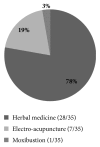A Review of Complementary and Alternative Medicine Therapies on Muscular Atrophy: A Literature Review of In Vivo/In Vitro Studies
- PMID: 30581489
- PMCID: PMC6276427
- DOI: 10.1155/2018/8654719
A Review of Complementary and Alternative Medicine Therapies on Muscular Atrophy: A Literature Review of In Vivo/In Vitro Studies
Abstract
Objective: The objective of this review is to evaluate the recent treatment and study trends of complementary and alternative medicine (CAM) treatments on muscular atrophy by reviewing in vivo/in vitro studies.
Materials and methods: The searches were conducted via electronic databases including PubMed, the Cochrane Library, China National Knowledge Infrastructure (CNKI), Wanfang MED, and five Korean databases. Only in vivo and in vitro studies were included in this study.
Results: A total of 44 studies (27 in vivo studies, 8 in vitro studies, and 9 in vivo with in vitro) were included. No serious maternal or fetal complications occurred. There were various animal models induced with muscular atrophy through "hindlimb suspension", "nerve damage", 'alcohol or dexamethasone treatment', "diabetes", "CKD", "stroke", "cancer", "genetic modification", etc. In 28 of 36 articles measuring muscle mass, CAM significantly increased the mass. Additionally, 10 of them showed significant improvement in muscle function. In most in vitro studies, significant increases in both the diameter of myotubes and muscle cell numbers were reported. The mechanisms of action of protein synthesis, degradation, autophagy, and apoptotic markers were also investigated.
Conclusions: These results demonstrate that CAM could prevent muscular atrophy. Further studies about CAM on muscular atrophy are needed.
Figures
Similar articles
-
Amelioration of muscle wasting by glucagon-like peptide-1 receptor agonist in muscle atrophy.J Cachexia Sarcopenia Muscle. 2019 Aug;10(4):903-918. doi: 10.1002/jcsm.12434. Epub 2019 Apr 24. J Cachexia Sarcopenia Muscle. 2019. PMID: 31020810 Free PMC article.
-
Complementary/alternative medicine in the treatment of asthma.Ann Allergy Asthma Immunol. 2000 Dec;85(6 Pt 1):438-47; quiz 447-9. doi: 10.1016/S1081-1206(10)62569-0. Ann Allergy Asthma Immunol. 2000. PMID: 11152164 Review.
-
Disuse muscle atrophy-improving effect of ninjin'yoeito in a mouse model.Neuropeptides. 2021 Dec;90:102199. doi: 10.1016/j.npep.2021.102199. Epub 2021 Sep 23. Neuropeptides. 2021. PMID: 34610544
-
Protective effects of Liuwei dihuang water extracts on diabetic muscle atrophy.Phytomedicine. 2019 Feb;53:96-106. doi: 10.1016/j.phymed.2018.09.032. Epub 2018 Sep 5. Phytomedicine. 2019. PMID: 30668418
-
Complementary and alternative therapies for back pain II.Evid Rep Technol Assess (Full Rep). 2010 Oct;(194):1-764. Evid Rep Technol Assess (Full Rep). 2010. PMID: 23126534 Free PMC article. Review.
Cited by
-
Z-ajoene from Crushed Garlic Alleviates Cancer-Induced Skeletal Muscle Atrophy.Nutrients. 2019 Nov 10;11(11):2724. doi: 10.3390/nu11112724. Nutrients. 2019. PMID: 31717643 Free PMC article.
-
The Influence of Interpersonal Behaviors and Population Density on Grip Strength of Elderly People: An Analysis of the Direct vs. Indirect Effects via Social Participation.Front Public Health. 2021 Dec 10;9:755695. doi: 10.3389/fpubh.2021.755695. eCollection 2021. Front Public Health. 2021. PMID: 34957015 Free PMC article.
-
16th Meeting of the Interuniversity Institute of Myology (IIM) - Assisi (Italy), October 17-20, 2019: Foreword, Program and Abstracts.Eur J Transl Myol. 2020 Sep 15;30(3):9345. doi: 10.4081/ejtm.2020.9345. eCollection 2020 Sep 30. Eur J Transl Myol. 2020. PMID: 33117514 Free PMC article.
-
Efficacy and safety of thread embedding acupuncture for facial expression muscles atrophy after peripheral facial paralysis: study protocol for a randomized controlled trial.Trials. 2021 Oct 30;22(1):755. doi: 10.1186/s13063-021-05696-6. Trials. 2021. PMID: 34724965 Free PMC article.
-
Herb-Induced Liver Injury: Phylogenetic Relationship, Structure-Toxicity Relationship, and Herb-Ingredient Network Analysis.Int J Mol Sci. 2019 Jul 25;20(15):3633. doi: 10.3390/ijms20153633. Int J Mol Sci. 2019. PMID: 31349548 Free PMC article. Review.
References
Publication types
LinkOut - more resources
Full Text Sources





